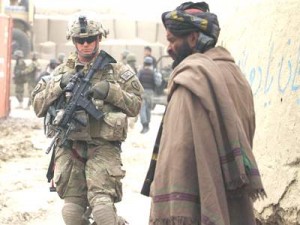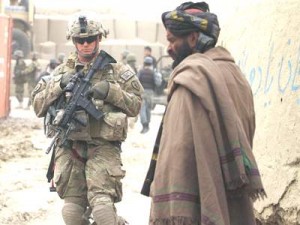Newsweek
MARK MOYAR
Part II
 To permit rapid enlargement of the Afghan forces, the United States boosted funding and the number of American trainers. It also lowered recruiting standards for the Afghan army and police and shortened training, with the result that the enlarged Afghan forces suffered from the indiscipline and incompetence common to ill-led security units.
To permit rapid enlargement of the Afghan forces, the United States boosted funding and the number of American trainers. It also lowered recruiting standards for the Afghan army and police and shortened training, with the result that the enlarged Afghan forces suffered from the indiscipline and incompetence common to ill-led security units.
In 2011, Obama curtailed America’s counterinsurgency effort in Afghanistan by cancelling large-scale clearing operations in eastern Afghanistan. The lack of a sustained counterinsurgency campaign allowed the insurgents to recruit replacements across the east. Those insurgents now provide safe haven for other terrorists and pose an existential threat to the Afghan government.
4. Over-reliance on Surgical Strikes
From 2002 to 2008, the small US military forces in Afghanistan relied primarily on raids and ambushes to thwart Afghan insurgents and their Al-Qaeda allies.
Although the Americans inflicted heavy losses, they could not keep the insurgents from gaining in strength. The subsiding of violence in Iraq in 2008 permitted the shifting of US military resources to Afghanistan, prompting recommendations from the military leadership—including surgical-strike pioneer General Stanley McChrystal—to shift from surgical strikes to troop-intensive counterinsurgency. In late 2009, Obama consented to counterinsurgency and the additional troops it required.
Obama’s cancellation of counterinsurgency operations in eastern Afghanistan in 2011 necessitated a move back toward a strategy reliant on surgical strikes. Although drones and raids inflicted heavy losses, they failed to hold the enemy at bay in eastern Afghanistan.
With the withdrawal of American troops, the security situation deteriorated to such a degree that in early 2014 the CIA had to shut down its outlying Afghan bases and its secret army of Afghan counter-terrorists—assets that were critical to surgical strikes.
In 2008, President Bush began precision drone strikes in Pakistan against al Qaeda and other extremists. The Obama administration increased the rate of strikes, but by then al Qaeda had taken effective countermeasures, to include the relocation of leaders into urban areas where drone strikes were off-limits.
Obama’s drone effort killed mainly low-level fighters from the Pakistani Taliban, an extremist organization of greater concern to Pakistan than to the United States. The drone program depended heavily on cooperation from Pakistan’s Inter-Services Intelligence agency, which often was unable or unwilling to provide targeting information to the United States.
Najibullah Zazi, the would-be subway bomber, and Faisal Shahzad, who drove an SUV bomb into Times Square, received their terrorist training in Pakistan at the peak of the drone strikes.
Because of the Pakistani government’s unwillingness to authorize U.S. ground operations inside Pakistan, the United States conducted only a handful of special operations raids in Pakistan between 2005 and 2011. The last of those raids, which killed Osama bin Laden, provoked such an outcry that the Pakistanis expelled American special operations forces from the country, shut down the main U.S. drone base, and obstructed CIA activities.
The United States has conducted no subsequent raids in Pakistan and its drone program has been drastically curtailed. Al-Qaeda and other extremist organizations are now regenerating in Lahore, Karachi and other sprawling cities.
In Yemen, U.S. military officers argued that the United States should help government forces secure the country’s rural areas by supporting counterinsurgency operations, but the Obama administration chose to rely exclusively on surgical strikes to counter Al-Qaeda in the Arabian Peninsula (AQAP).
While drones killed a number of key AQAP figures, the lack of counter-insurgency operations allowed AQAP and Houthi rebels to gain ground. Enemy control of the population reduced American access to information, which in turn impeded drone targeting and led to misdirected strikes that killed women and children.
Exploiting those mishaps to recruit new followers, AQAP increased in size from three hundred to more than a thousand during the period of sustained U.S. drone strikes. Obama’s Yemen strategy of counter-terrorism without counter-insurgency collapsed entirely at the beginning of 2015, when insurgents overran the capital, dismantled the Yemeni security services, and drove out the CIA.
According to U.S. spokesmen, precision air strikes have killed thousands of ISIS fighters in Syria and Iraq. Yet ISIS appears no weaker now than when the air campaign began more than one year ago. It has undertaken effective countermeasures to protect key personnel and has recruited thousands of new followers in the areas it occupies, in addition to attracting foreign radicals. The air strikes failed to prevent it from seizing one of its biggest prizes, the Iraqi city of Ramadi.
5. Refusal to Commit a Military Footprint
In 2011, the United States and its European allies used air power to help rebels destroy the Gadhafi regime, then touted Gadhafi’s death as proof that they could achieve their objectives without deploying their own ground forces. While the absence of U.S. ground forces from Libya kept the United States from sustaining casualties, it also prevented the attainment of lasting strategic success.
In the chaotic aftermath of Gadhafi’s overthrow, no forces intervened to secure critical Libyan facilities, as U.S. forces had done at Iraqi facilities in 2003. The doors to Gadhafi’s prisons were flung open and untold numbers of extremist leaders escaped. Miscreants looted the regime’s armories of heavy weapons and surface-to-air missiles. When insurgents flouted the new government’s authority, no foreign troops could beat them back, as American troops had done in Iraq and Afghanistan.
In the case of Syria, Obama refused to send American ground troops to assist rebel forces, despite warnings from his military experts that American ground troops would be required to give the rebels a chance of succeeding. Obama reportedly hoped that American-backed rebels could assert enough strength on their own to force a negotiated solution of the conflict. When inserted into Syria, however, the rebels have been kidnapped, killed, or turned almost to a man.
6. Refusal to Maintain a Military Footprint
In Iraq, the tactical military successes of 2007 and 2008 led to several years of strategic success, during which Iraqis stopped fighting the government and participated increasingly in the democratic process. Vice President Joe Biden declared in 2010, “You’re going to see a stable government in Iraq that is actually moving toward a representative government.” According to Biden, the political advancement of Iraq “could be one of the great achievements of this administration.”
At the end of 2011, President Obama withdrew all U.S. forces from Iraq while asserting that a large American civilian presence would suffice to preserve stability. The American civilian presence, however, failed to contain Iraq’s sectarian impulses as U.S. military forces had.
As soon as the last U.S. troops left the country, al-Maliki rounded up Sunni politicians en masse and purged Sunni officers from the security forces. He also curtailed U.S. intelligence activities, leading to a sharp degradation of counterterrorism operations. These developments paved the way for the rise of ISIS in 2014.
When Obama sent American forces back to Iraq in 2014, he constrained their effectiveness by keeping them few in number and confining them to bases. American troops could not exert nearly as much political and military influence as the Iranian personnel in Iraq and the 100,000 Iraqi Shiite militiamen whom the Iranians had trained.
As a consequence, the United States has been unable to rehabilitate the Iraqi national security forces or regain Sunni confidence.
7. Signaling of Retrenchment
Another reason behind the Obama administration’s inability to turn tactical successes in Afghanistan into strategic gain has been the Afghan perception that Obama planned to abandon the country.
This perception arose from Obama’s frequent statements about removing American forces from Afghanistan, beginning with his West Point speech in December 2009. It received reinforcement from the successive withdrawals of American troops from 2011 onward.
Opportunistic Afghans supported the insurgents in the belief that the Americans would depart before the Afghan government was strong enough to fend off the insurgents on its lonesome. Pakistan, interpreting America’s departure from Afghanistan as the segue to Indian domination of the country, stepped up support for the Taliban and Haqqani network.
Voluminous foreign complaints about American intervention in Afghanistan and Iraq have obscured the fact that those interventions instilled respect and fear of the United States in much of the world.
By overthrowing hostile regimes and maintaining a U.S. presence in the face of vicious insurgencies, the United States dispelled the notion—encouraged by the abandonment of South Vietnam in 1975 and the Black Hawk Down episode of 1993—that it was unwilling to stomach prolonged and costly military expeditions. America’s adversaries, in such places as Damascus, Tehran, Moscow, Beijing, and Pyongyang, took note.
For a time, therefore, America’s military accomplishments in Afghanistan and Iraq worked to its strategic advantage elsewhere.
The respect and fear began to subside in December 2009 with Obama’s announcement of his Afghanistan withdrawal timeline and tumbled sharply in late 2011 with the evacuation of American forces from Iraq. American prestige fell still further with the Syrian “red line” debacle, Russia’s unchecked aggression against Ukraine and the rise of ISIS.
The United States thereby suffered a decline in its strategic position on issues such as Iran’s nuclear program, the China Development Bank and the Syrian civil war.



